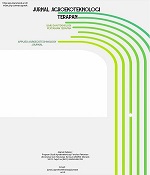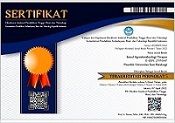Polyembryony in Avocado Fruit Plants (Persea americana mill)
DOI:
https://doi.org/10.35791/jat.v3i1.40259Keywords:
pests, sweet corn, WoloanAbstract
The purpose of this study was to determine the properties of polyembryony in avocados, to determine the number of seeds produced from embryonic traits, and determine the relationship between polyembryony and seedling growth.
The problem in planting avocados is that it is not known with certainty the properties or characteristics of avocado seeds, so this greatly affects the availability of avocado seeds as well as the relationship between polyembryony and seedling growth, whether by planting whole seeds one, whole in two, whole in three or split in two or in three. can provide better seedling growth.
The results showed that whole avocado polyembryonic seeds which had one embryo, two embryos, and three embryos, and polyembryonic seeds which were halved, and halved, all could be recommended as seeds. Due to the viability, and high vigor, the viability is the same and exceeds 80%. Next seedlings derived from whole seeds (not polyembryony) in avocado showed better growth than seeds from polyembryony which had two embryos and three embryos, and seeds from split polyembryony tended to show better growth differences compared to intact polyembryo.
Keywords: Â pests, Â sweet corn, Woloan
Abstrak
Tujuan penelitian ini mengetahui sifat-sifat poliembrioni pada buah alpukat, mengetahui jumlah bibit yang dihasilkan dari sifat embrioni serta mengetahui hubungan antara poliembrioni dengan pertumbuhan bibit.
Masalah dalam penanaman buah alpukat adalah belum diketahui dengan pasti sifat-sifat atau karakteristik benih alpukat, sehingga hal ini sangat mempengaruhi ketersediaan benih alpukat juga hubungan poliembrioni dengan pertumbuhan bibit apakah dengan penanaman biji utuh satu,utuh dua, utuh tiga atau belah dua atau belah tiga dapat memberikan pertumbuhan bibit yang lebih baik.
Hasil penelitian menunjukkan bahwa benih poliembrioni alpukad utuh yang mempunyai embrio satu, embrio dua maupun embrio tiga, serta, benih poliembrioni yang dibelah dua, dan belah tiga, semuanya dapat direkomendasikan dijadikan bibit. Karena viabilitas, dan vigor tinggi, viabilitasnya sama dan melebihi 80%. Selanjutnya bibit yang berasal dari benih utuh satu (bukan poliembrioni) pada alpukad menunjukkan pertumbuhan yang lebih baik di banding bibit yang berasal dari poliembrioni yang mempunyai embrio dua dan embrio tiga, dan bibit yang berasal dari poliembrioni yang dibelah cendrung menunjukkan perbedaan pertumbuhan yang lebih baik dibanding dengan poliembrio utuh.
Kata Kunci : Poliembrioni, Produksi Benih, Alpukat
References
Bowman KD, Gmitter FG, Hu. 1995 Reationships of Seed Size and shape with Polyembryony and the zygotic or Nucellar origin of citrus Spp. Seedlings
Byrd, H.W. 1983. Pedoman Teknologi Benih. PT Pembimbing Masa.
Copeland, L.O. and M.B.McDonald, 1985. Principles of Seed Science and Technology. Mac Millan Pub.Co.New York.
Gomez, A.G. and A Gomez, 1984 Statistical Procedures for Agricultural research. An International Rice Research Institute Book. Secon Edition.
Kamil, J. 1982. Teknologi Benih. Penerbit Angkasa Bandung.
Mardjuki, A. 1994. Pertanian dan Masalahnya. Penerbit Andi offset Yogyakarta.
Mugnisjah, W.Q dan A. Setiawan 1990. Pengantar Produksi Benih. Fakultas Pertanian IPB. Penerbit Rajawali Pers. Jakarta.
Rahardjo, P dan Soedarsono 1987. Pengaruh letak Benih dalam buah terhadap Perkecambahan dan Vigor Bibit Cacao.
Sadwiyanti L, D Sudarso, T Budiyanti 2009. Petunjuk Teknis Budidaya Alpukat. Balai Penelitian Tanaman Buah Tropik Pusat Penelitian dan Pengembangan Tanaman Buah Tropika
Sudarti, T.S. 1977. Teknologi Benih I. Laboratorium Teknologi Benih . Departemen Agronomi Fakultas Pertanian UGM. Penataran Purna Sarjana Ilmu Hortikultura.
Sutopo L, 1998. Teknologi Benih. Jakarta PT RajaGrafindo Persada
Downloads
Published
How to Cite
Issue
Section
License

This work is licensed under a Creative Commons Attribution-NonCommercial 4.0 International License.





















